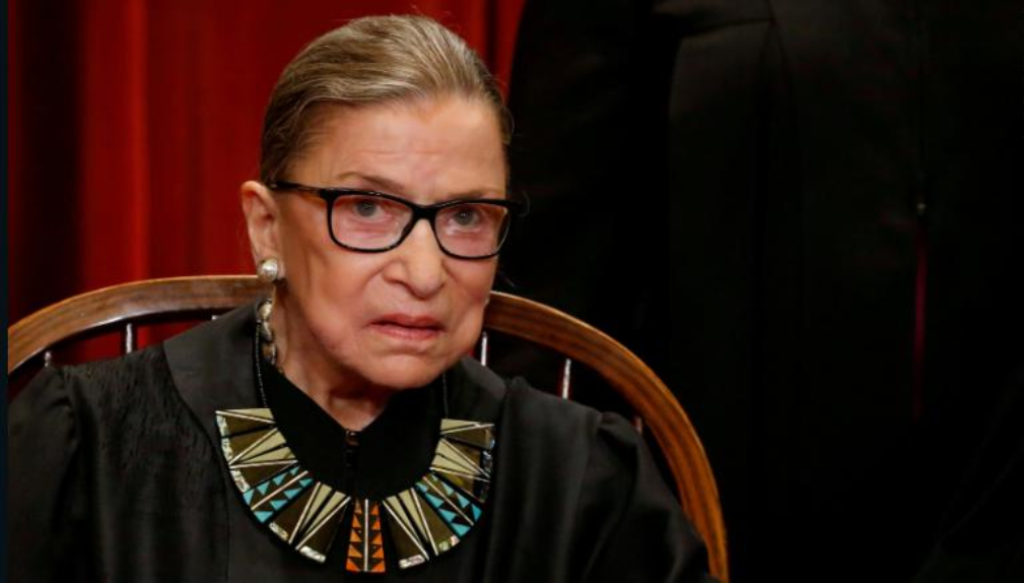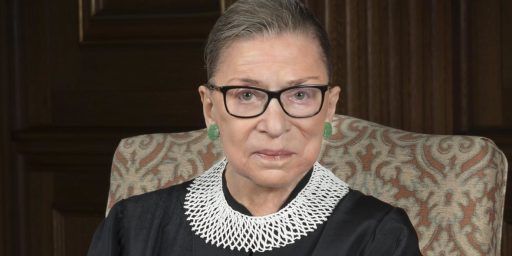Ruth Bader Ginsburg Has Cancer Treatment For Second Time In A Year
Justice Ruth Bader Ginsburg underwent three weeks of cancer treatment earlier this summer. The second such treatment in a year, and the fourth in the last twenty years.

Late yesterday, the Supreme Court informed the press that Justice Ruth Bader Ginsburg had undergone cancer treatment for the second time in less than a year:
Justice Ruth Bader Ginsburg underwent treatment for a malignant tumor discovered on her pancreas, according to a news release issued by the Supreme Court on Friday.
“The tumor was treated definitively and there is no evidence of disease elsewhere in the body,” the statement said.
The abnormality was first discovered in early July after a routine blood test, according to the statement. A biopsy conducted on July 31 at Memorial Sloan Kettering Cancer Center in New York City confirmed a localized malignant tumor.
“Justice Ginsburg will continue to have periodic blood tests and scans,” the statement said. “No further treatment is needed at this time.”
The health of the 86-year-old justice, the senior member of the court’s four-member liberal wing, has been a subject of concern.
In December, surgeons removed two malignant nodules from Justice Ginsburg’s left lung. The court described that surgery as successful, and said then that she was cancer free. After missing two weeks of arguments in January, she returned to work in February.
Justice Ginsburg also had surgery in 2009 for early-stage pancreatic cancer.
She was also treated for colon cancer in 1999, but she did not miss a day on the bench.
(…)
For three weeks this August, Justice Ginsberg underwent focused radiation treatment, and a bile duct stent was placed, according to the court’s statement.
Dr. Diane Simeone, director of pancreatic cancer at NYULangone’s Perlmutter Cancer Center, said the preferred treatment for a localized tumor is surgery to remove it, but said she was not familiar with the details of this particular case. Radiation “is not typically given as first-line treatment for a newly diagnosed pancreatic cancer,” she said.
“The question is: Where does this fit in the big picture?” Dr. Simeone said. “She had a pancreatic cancer resectioned about a decade ago. Is this a second primary tumor? Is this a local recurrence? Those are things that are unclear from the information we have today.”
Though pancreatic cancer has a reputation as an aggressive and fast-moving disease, Dr. Simeone said some subtypes are indolent and slow-growing. Some of them have a tendency to spread to the lungs and might have been implicated in the justice’s lung cancer.
“It’s hard to know the prognosis without knowing the true extent of the tumor,” she said. Radiation can be effective for local control but “it’s often not curative,” she said
More from The Washington Post:
Justice Ruth Bader Ginsburg confronted another bout with cancer this month and on Friday completed radiation treatment for a malignant tumor found on her pancreas, the Supreme Court disclosed.
It was the second treatment for cancer in nine months for the court’s oldest member and leader of its liberal wing. The 86-year-old had a lobe of her left lung removed in December, and in the past was treated both for colon and pancreatic cancer.
The court said the three-week treatment for her current condition began earlier this month at Memorial Sloan Kettering Cancer Center in New York, and no additional treatment is planned.
“The tumor was treated definitively and there is no evidence of disease elsewhere in the body,” the court’s spokeswoman said in a statement. “Justice Ginsburg will continue to have periodic blood tests and scans. No further treatment is needed at this time.”
Experts on pancreatic cancer said there was no indication Ginsburg’s ability to serve on the court will be affected, but cautioned it was difficult to make predictions about her prognosis based on the scant details provided by the court.
Louis Weiner, director of the Georgetown Lombardi Comprehensive Cancer Center, whose research focuses on pancreatic treatment models, said “there is reason to be optimistic that she will do well and will be able to continue work.”
Weiner said “high-dose, localized radiology to a particular part of the body will eradicate pancreatic cancer cells. The radiology typically works very successfully.”
A less-optimistic view of the use of radiation is that it is for “tumor control rather than cure,” said Diane Simeone, director of the Pancreatic Cancer Center at NYU Langone Health’s Perlmutter Cancer Center and a specialist in pancreatic cancer. “It’s a little bit uncommon to just do radiation only,” she said. “It’s often used for disease control. It’s not often a curative approach.”
Ginsburg seems to have tolerated the outpatient treatment well; she was at work at the Supreme Court on Friday afternoon after receiving her final treatment in New York during the morning.
She has maintained an active schedule of speaking engagements throughout the treatment, and last week attended an off-Broadway production of “Fiddler on the Roof.” Photographs of her meeting actor Kate McKinnon, who portrays Ginsburg on “Saturday Night Live,” lit up social media.
Ginsburg is one of the oldest justices to serve on the Supreme Court, and her health is a constant matter of concern and speculation for both liberals and conservatives. Her inability to serve would provide President Trump with a chance to nominate a third conservative to the high court and shift it further to the right.
Ginsburg said in speeches and in an interview last month that her health was fine, and she would continue to serve as long as she felt up to the job.
“I was okay last term; I expect to be okay next term, and after that we’ll just have to see,” Ginsburg said July 24 at an appearance in Washington. According to the court’s statement, that event was after an abnormality was detected in a routine blood test, but before a biopsy confirmed a “localized malignant tumor.”
(…)
Pancreatic cancer is particularly dangerous, but Ginsburg in an interview with NPR last month made light of predictions about her fate at the time.
“There was a senator, I think it was after my pancreatic cancer, who announced, with great glee, that I was going to be dead within six months,” she recalled in the interview. “That senator, whose name I have forgotten, is now himself dead, and I am very much alive.”
The senator was Jim Bunning (R-Ky.), who later apologized for his remarks.
Weiner said Ginsburg’s previous cancers made it more likely that an additional tumor would be found at an early, treatable stage.
“Localized measures have an excellent chance of being useful” when a tumor is detected early, Weiner said.
The five-year survival rate for pancreatic cancer is quite low when compared with other forms of the disease, though people with localized tumors do better, according to the American Cancer Society. Ginsburg has already survived for 10 years after one bout with the disease. The survival rates are also skewed by the fact that pancreatic cancer is often not detected until it has spread significantly.
In light of Ginsburg’s cancer history, Simeone speculated that she might have a subtype of the disease that is less aggressive and grows more slowly. However, she said she could not be sure without knowing more about Ginsburg’s lung and colon cancers.
Nadia Laack, chair of radiation oncology at the Mayo Clinic in Rochester, Minn., said she suspected that Ginsburg’s tumor is a new cancer, rather than a recurrence. “Normally, pancreatic cancer recurs fairly quickly, generally in the next two years,” she said.
Three justices older than Ginsburg have served in the court’s history: Oliver Wendell Holmes, John Paul Stevens and Roger B. Taney. Stevens, who served with Ginsburg and who died in July, was 90 when he retired in 2010, and Holmes served until he was almost 91.
Here’s the press release from the Court:
Justice Ruth Bader Ginsburg today completed a three-week course of stereotactic ablative radiation therapy at Memorial Sloan Kettering Cancer Center in New York City. The focused radiation treatment began on August 5 and was administered on an outpatient basis to treat a tumor on her pancreas. The abnormality was first detected after a routine blood test in early July, and a biopsy performed on July 31 at Sloan Kettering confirmed a localized malignant tumor. As part of her treatment, a bile duct stent was placed. The Justice tolerated treatment well. She cancelled her annual summer visit to Santa Fe, but has otherwise maintained an active schedule. The tumor was treated definitively and there is no evidence of disease elsewhere in the body. Justice Ginsburg will continue to have periodic blood tests and scans. No further treatment is needed at this time.
This is the fourth time that Ginsburg has received cancer treatment over the past twenty years, and the second time she’s done so inside of a year. She was first diagnosed with colon cancer in 1999 and underwent surgery and post-surgical treatment for that cancer but did not miss a day on the court and was subsequently released from care. Ten years later, she underwent treatment for pancreatic cancer that was similarly successful and also did not miss any time on the court. Most recently, she underwent treatment last December for what were described at the time as cancerous nodules on one of her lungs. That treatment was considered successful, but it did result in Ginsburg being unable to participate in most of the Court’s January sitting, although she did participate in the cases by reading the transcripts of argument and participating in the post-argument discussion of the cases with her colleagues via teleconference. Ginsburg was declared cancer-free from that December treatment in mid-January and seemed by all observers to be in fine health for the remainder of the term that ended in June.
At 86, Ginsburg is the oldest and second-longest serving Justice on the Court today and is among the oldest Justices ever to serve on the nation’s highest court. Obviously, given her age and her medical history, any report of a recurrence or reappearance of cancer, or a new case which appears to be what happened here is a big concern. In all likelihood, though, it is Ginsburg’s history of cancer that led to what appears to be the early discovery of this latest tumor, which hopefully led to its early eradication. Ordinarily, pancreatic cancer is a form of the disease that can be both hard to treat and cure and hard to detect, two factors that lead to its relatively high fatality rate. In that respect, Ginsburg is most likely fortunate that her previous medical history means that she likely has far more aggressive cancer screenings than an ordinary person of her age might.
All that being said, Ginsburg’s advanced age and her previous medical history means that any development like this raises concerns about her health and how long she might be able to continue serving on the Court. As I’ve noted before, she has given no indication that she intends to step down voluntarily any time soon, and has at least implicitly made it clear that she would not do so as long as Donald Trump was President. More specifically, she has said publicly that she intends to continue in her position as long as she believes she is able to continue doing the job. Here’s hoping that she’ll be healthy and ready to go when the Court reconvenes on October 7th.





Notorious R.B.G:
“I ain’t got time for cancer.” (Chews on unlit cigar and opens up with her minigun.)
Despite his actions on Merrick Garland, I fearlessly predict that should RBG resign or pass, no matter when, Leonard Leo will put up a Federalist Stepford nominee, Trump will rubber stamp it, and Mitch McConnell will destroy any rule or norm to try to ram through a confirmation as late as Jan 20, 2021. Jan 3 if the Ds pick up the senate. It will suddenly be an unprecedented emergency that we’re short a Justice and something must be done immediately.
I suppose I should allow the possibility that one or two R senators would fail to go along with a bum’s rush confirmation, if we’re within a few weeks of Trump’s departure. Heck, once he’s won reelection and Trump has lost, even Lyndsay Graham may become moderate again.
@gVOR08:
I suppose he knows if he does that, the Democratic president will nominate seven additional justices to the Court.
…and Trump has lost…
I’ll believe it when I see it…on Fox News…
Hang in there, RBG, we’re all counting on you!
@Kathy: And the next Republican President will up that by an additional 9.
As much as I admire her, I wish she had resigned early in Obama’s second term. I’ve known five people who had pancreatic cancer and there isn’t one of them around today. RBG has lasted longer than most. We will have a 6-3 court for a couple of generations.
Not if the number of seats on the court is expanded…